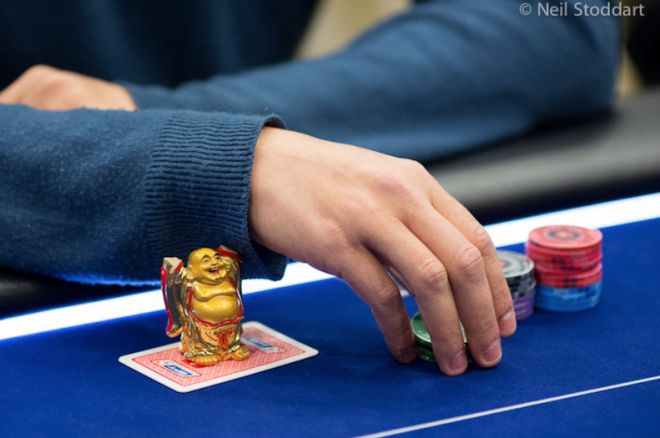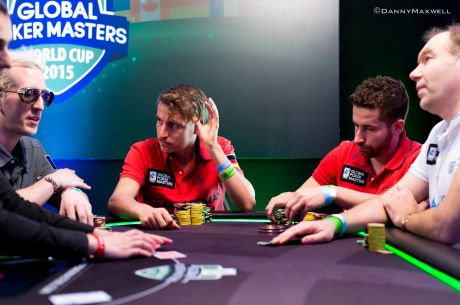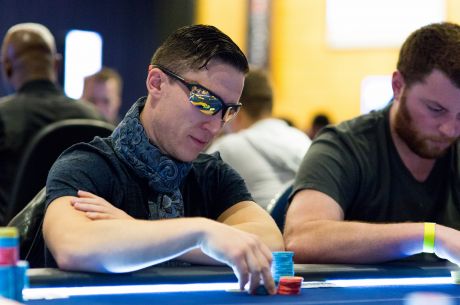Avoid the Accidental Muck By Always Protecting Your Cards

The bubble was approaching. I was in the big blind with an average stack. Just a few more eliminations and we’d be in the money.
A hand arose in which I was in the big blind and I watched the player to my left open-raise his short stack all in for about 17,000 — a little over 10 big blinds’ worth at the time. It folded around to a quiet, elderly gentleman in Seat 5 who exhaled and said “Okay” as he slid forward his even shorter stack of about 12,000.
The player next to him on the button folded, and as I was starting to look at my hand I suddenly heard the older player saying something in an agitated fashion. I quickly looked up and immediately realized what was bothering him.
The lone column of chips he had pushed forward still sat before him, topped by a circular medallion he’d been using as a card protector. But something else — something important — was missing.
There were no cards.
That’s right. His cards had been mucked. He was all in, but he had no hand left to play!
This happened a while ago during an event I’d played at the Golden Nugget, part of their Grand Poker Series that is one of many fun, low buy-in tourney series that generally happen in Las Vegas during the summer. I was there helping cover the World Series of Poker for PokerNews, having taken advantage of a day off to go play the tournament with some friends.
At the time there were 23 of us left, and the top 18 got paid. I’d managed to outlast all of my buddies (winning a “last longer” bet between us), and was hoping to hold on to make the cash and perhaps a final table run.
It had been a long day of poker as we’d started at noon and it was already past 10 p.m. I myself was starting to get a little fatigued. Not being a professional player, I’m not one who is used to spending long days at the tables. I have a feeling fatigue might have been a factor for my unfortunate opponent, too, who soon had transformed from a quiet participant into a loud and angry non-participant.
I was reminded of the incident while reading through some of Robert Woolley’s articles introducing “Casino Poker for Beginners.” If you haven’t read any of them yet, Woolley has so far moved through various steps involved in sitting down and playing poker in a live setting, including buying chips, taking a seat, and some of the mechanics of game play.
In one recent piece from last week Woolley focused in particular on the procedures involved with making bets — that is, how players are expected to handle their chips when moving them forward to bet or raise. In that one Woolley warned new players against trying to make what is called a “string bet” or “string raise” (not allowed). Then in yesterday's article he explained the “oversize chip rule.”
Both of those explanations reminded me of mistakes I had made when sitting down in a live casino poker game for the first time. Indeed, the series has given me a lot of “I-wish-I-had-known” moments already. Thankfully, though, I’ve never made the mistake made by the elderly gentleman on the bubble of my Golden Nugget tournament.
The lesson is a relatively obvious one — always, always, always protect your cards while in a hand. It becomes even more crucial to do so, of course, in those hands in which you have committed chips to the pot, and most vital when you’re all in as my poor opponent was.
I mentioned how he was in Seat 5, which meant he was right across from the dealer. If you were paying attention to details you noticed I also mentioned how the player had a card protector, but instead of using it to protect his cards it was sitting on top of the stack of chips he had slid forward.
Card protectors work well — if you use them to protect your cards, that is. So, too, does setting a chip or multiple chips atop your cards while in a hand. You can also simply use your hands to protect your cards, as long as it remains clear to everyone else that you still have cards and have not folded. However you do it, keep those cards protected and don’t let a dealer sweep your cards away accidentally as can happen if you haven’t prevented him or her from doing so.
As my own attention was diverted — I had begun to look down at my cards when all of the excitement began to erupt — I didn’t quite see how the older fellow’s cards had found their way into the muck. But many others had, and once the floor person was called over it was all explained many times over.
It sounded as though the player’s cards had been pushed slightly forward, too, along with the chips, which was what led to the dealer scooping them away. They couldn’t be retrieved, and so when the rest of us folded, the all-in player to my left won the hand and the elderly player was eliminated.
The incident was similar to one that happened several years ago at the WSOP in a hand involving Estelle Denis and JC Tran, which some might remember. Take a look:
“The dealer made a mistake, but it’s the players’ responsibility to protect their hand,” explains Norman Chad in his commentary. In Denis’s case she was reraising all in over Tran’s initial raise, which meant she only lost the chips needed to call Tran’s bet and thankfully was not eliminated.
But alas for my opponent last summer, he was calling another player’s all-in — one who had him covered — and there was nothing that could be done. After his stormy exit the rest of us were all sympathetic to his plight. Many described having seen similar mistakes made in the past, although most agreed it usually happened to players sitting in Seat 1 or Seat 9/10 — that is, to players sitting right next to the dealer (like Denis) — and not to players sitting across the table.
But even if we were all sympathetic, I don’t think anyone also didn’t mind moving one step closer to the money thanks to the mistake.
I did manage to make it to the money, by the way, before pushing all in with AxJx, getting called by an opponent who had AxKx, and failing to improve.
At least I was able to table two cards on my last hand.
Get all the latest PokerNews updates on your social media outlets. Follow us on Twitter and find us on both Facebook and Google+!








